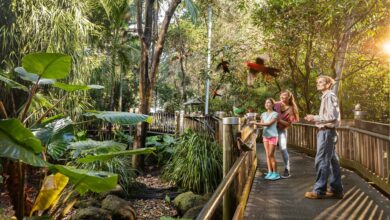Have you ever seen a Caper White Butterfly or Rainbow Bee-Eater? Would you know how to spot an ornate burrowing Frog or Red-necked Wallaby?
A new book series commissioned by Ipswich City Council has drawn on decades of field experience by local wildlife photographers, authors and surveyors Damian White and Narelle Power of ddwfauna to highlight our rich diversity of wildlife.
Damian and Narelle are lucky to be able to indulge two of their greatest passions – discovering wildlife and photography – whether it’s with ddwfauna creating baseline data for a council conservation estate or on a camping holiday chasing rare dragonflies.
The majority of images in the new wildlife book series are drawn from the extensive ddwfauna database.
With the 2018 Enviroplan photography competition open for entries, Narelle and Damian have shared their tips for photographing the incredible diversity of wildlife in Ipswich.
“The more people who appreciate what we’ve got, the more likely we are to save it,” Narelle said.
your chance to win
Taken a terrific nature-based shot? Enviroplan Photo Competition is open for both website and Instagram entries until August 24, 2018
Location
There is never any guarantee when dealing with nature. “If you’re interested, have your camera with you all the time. You may be driving along and you’ll see a great species,” Narelle said.
Some of their best photos were taken in their Ipswich backyard, but their top spot in Ipswich for fauna is White Rock – Spring Mountain Conservation Estate.
“It’s phenonmenal,” Narelle said.
“It’s the number one for us,” Damian added. “After the rain you will have 15-16 species of frogs just outside your car.”
Denmark Hill is also a great spot, close to Ipswich’s population centre. Haig Street Quarry Reserve is good for bird watching, and Colleges Crossing has interesting critters such as fireflies. Queens Park is a great place for beginners – the Nature Centre’s bird aviary is a good place to practice, and Nerima Gardens is a hotspot for dragonflies.
Time
The best time of day, or year, all depends on the species you are after. Just a point though – if you go night frogging, remember snakes like to go night frogging too.
It’s generally best to sit quietly and wait, rather than just walking around. Birds, for instance, will return to their normal behaviour when they see you’re not a threat.
Camera
Narelle said modern mobile phones can take great photos. “Don’t look at a professional photo and be discouraged because yours doesn’t look the same,” she said. “You may not have the same equipment, and you don’t know how it was treated (in post production).”
If you have a digital SLR camera, you may want a zoom lens if photographing birds, whereas insects will probably need a macro lens for a top shot.
Damian said Facebook was a terrific forum for advice. There’s local or state speciality groups such as butterflies, frogs or birds who can provide spotting information and species identifications, as well as local photography advice such as ‘Ipswich Behind the Lens’ or ‘Ipswich Photographic Society’.
Ethics
Just as important is the ethical side to wildlife photography. Narelle said a lot is common sense.
Don’t handle wildlife, and definitely don’t take things away to photograph them. Damian said observe and take the best photo you can, but don’t trample the environment to do it.
If you’re photographing nocturnal creatures remember that the flash affects their eyes. Don’t sit there with the torch on them – it would be like someone shining a spotlight in your face.
And make sure to clean your boots when leaving an area – you could be unwittingly spreading anything from weed seeds and fungi to frog disease.
The new wildlife books are not intended as a complete field guide, but rather to illustrate the variety of wildlife in Ipswich and provide residents with a localised tool for identifying common and iconic native species in the wild or their backyards.
One feature of the books I enjoy is reading where in Ipswich I might be able to spot a particular species. This creates a great connection to the fauna in our local areas.
The five books are Wildlife of Ipswich, Mammals of Ipswich, Frogs and Reptiles of Ipswich, Birds of Ipswich and Fish of Ipswich.
Printed copies will be made available to landholders in Bushland Conservation Agreements, Nature Conservation Agreements, Waterways Conservation Agreement, Koala Conservation Agreements and Land for Wildlife and can be viewed at council’s customer contact points such as divisional offices, libraries and Queens Park Environmental Centre.






